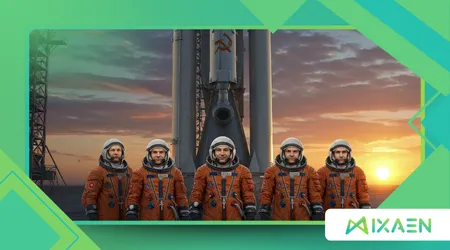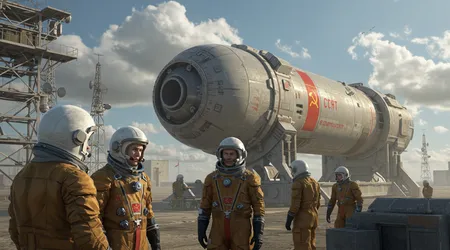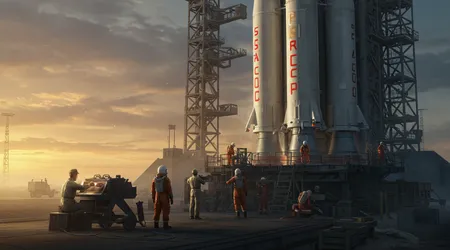Soviet Space Pioneers: Revisiting the Space Race from the East

Soviet Space Pioneers ignited humanity’s cosmic ambitions, launching the Space Race with audacious feats that reshaped global perceptions of technological prowess.
Anúncios
In the mid-20th century, the Soviet Union’s secretive yet groundbreaking space program stunned the world, achieving milestones that defined an era.
From the first satellite to the first human in orbit, their achievements were not just scientific triumphs but bold statements of ideological supremacy during the Cold War.
This exploration revisits the ingenuity, rivalries, and enduring legacy of the Soviet Space Pioneers, delving into their contributions with a fresh lens on their impact in 2025’s space exploration landscape.
Why did their bold steps into the cosmos resonate so deeply, and what can we learn from them today?
The Space Race wasn’t merely about reaching the stars; it was a battleground of ideologies, where scientific breakthroughs carried political weight.
The Soviet Union, under intense secrecy, orchestrated a series of firsts that challenged Western dominance.
Their story is one of visionaries like Konstantin Tsiolkovsky, whose theoretical work laid the foundation, and Sergei Korolev, the engineering genius who turned dreams into reality.
As we reflect in 2025, with private companies like SpaceX and international collaborations dominating headlines, the Soviet Space Pioneers offer timeless lessons in innovation, resilience, and the power of collective ambition.
This article uncovers their story, blending historical analysis with modern relevance, and invites readers to see the Space Race through an Eastern lens.
The Dawn of Cosmic Ambition
The Soviet Union’s space journey began long before Sputnik’s iconic beep echoed across the globe in 1957.
Konstantin Tsiolkovsky, a schoolteacher with a passion for physics, penned visionary theories in the late 19th century, calculating the rocket equation that would later propel humanity skyward.
His ideas, like seeds planted in fertile soil, inspired a generation of engineers. By the 1930s, the Group for the Study of Reactive Motion (GIRD) experimented with liquid-fueled rockets, setting the stage for monumental leaps. These early efforts, though modest, were the sparks that ignited a cosmic revolution.
Tsiolkovsky’s work wasn’t just theoretical it was prophetic. His 1929 concept of multistage rockets foreshadowed the designs that would conquer Earth’s gravity.
Meanwhile, engineers like Friedrich Zander and Yuri Kondratyuk explored gravity assists and lunar orbit rendezvous, ideas later critical to Apollo missions.
The Soviet Space Pioneers were not lone geniuses but part of a collaborative ecosystem, driven by a shared dream of the stars.
Their early experiments, often underfunded and overlooked, laid a foundation that would soon shake the world.
++ What the Artemis Program Could Mean for the Future of Humanity
This groundwork wasn’t without challenges. The Soviet system, with its competing design bureaus, fostered both innovation and rivalry.
Engineers like Korolev worked under political pressure, their successes tied to national pride. Yet, this crucible of competition birthed ingenuity.
In 2025, as we witness global space agencies collaborating on lunar bases, the Soviet Space Pioneers remind us that bold visions, even in adversity, can redefine what’s possible. Their early dreams set the stage for a race that captivated humanity.

Sputnik and the Shock of the New
On October 4, 1957, the Soviet Union launched Sputnik 1, the first artificial satellite, sending shockwaves through the Western world.
This 83.6-kilogram sphere, orbiting Earth every 96 minutes, was a triumph of engineering and propaganda.
According to NASA’s historical archives, Sputnik’s radio signals were detected globally, symbolizing Soviet technological superiority.
The Soviet Space Pioneers didn’t just launch a satellite; they launched a new era, forcing the U.S. to scramble in response.
Sputnik’s success wasn’t accidental. Sergei Korolev, the chief designer, orchestrated a meticulous plan, leveraging the R-7 Semyorka rocket, originally designed for intercontinental ballistic missiles.
This dual-purpose technology showcased the Soviet ability to repurpose military innovation for cosmic exploration.
Also read: The Legacy of Voyager: Humanity’s Most Distant Message
Imagine a chess grandmaster outmaneuvering an opponent with a single, brilliant move Sputnik was that move, bold and unexpected, shifting the global power narrative overnight.
The ripple effects were profound. The U.S. formed NASA in 1958, spurred by the need to counter Soviet advances.
In 2025, as private companies like Rocket Lab launch radar satellites from New Zealand, we see echoes of Sputnik’s legacy in democratizing space access.
The Soviet Space Pioneers proved that a single achievement could redefine global priorities, a lesson that resonates as nations and corporations race to colonize the Moon and Mars.
Humanity’s First Cosmic Steps
Yuri Gagarin’s 108-minute orbit on April 12, 1961, aboard Vostok 1 was a defining moment for humanity. As the first human in space, Gagarin became a global icon, his smile a symbol of Soviet triumph.
The mission, meticulously planned by Korolev, demonstrated the reliability of Soviet rocketry and life-support systems. Gagarin’s words, “Poyekhali!” (Let’s go!), echoed the fearless spirit of the Soviet Space Pioneers.
The Vostok program didn’t stop there. In 1963, Valentina Tereshkova became the first woman in space, orbiting Earth 48 times aboard Vostok 6.
Her mission, though partly driven by propaganda, highlighted the Soviet commitment to inclusivity in exploration.
Read more: How Cold War Tensions Shaped the Race to the Moon
Picture a marathon runner breaking the tape first Tereshkova’s flight was a similar breakthrough, proving space was for all. These milestones set records that stood unchallenged for years.
In 2025, as NASA’s Artemis program prepares for lunar landings, Gagarin and Tereshkova’s flights remind us of the human element in exploration.
The Soviet Space Pioneers showed that courage and ingenuity could transcend earthly rivalries.
Their success pressured the U.S. to aim for the Moon, illustrating how competition can drive progress, a dynamic still evident in today’s multinational space efforts.
Lunar Dreams and Robotic Explorers
The Soviet Union’s lunar program was a masterclass in robotic exploration. In 1959, Luna 1 became the first spacecraft to escape Earth’s gravity, followed by Luna 2, which impacted the Moon’s surface.
Luna 3 captured the first images of the Moon’s far side, revealing a hidden world. These missions, detailed in Britannica’s space exploration archives, showcased Soviet precision in uncrewed exploration.
The Lunokhod program took it further. In 1970, Lunokhod 1 became the first rover to roam another celestial body, covering 10.5 kilometers on the Moon.
Its success, driven by remote operators, was like a painter creating a masterpiece from afar delicate yet groundbreaking.
Luna 16, also in 1970, returned lunar soil to Earth, a feat unmatched until China’s Chang’e missions decades later. These achievements cemented the Soviet legacy in robotic exploration.
Today, as NASA’s Lunar Trailblazer mission maps lunar water, the Soviet Space Pioneers’ early robotic efforts remain relevant.
Their focus on automation paved the way for modern rovers like Perseverance. By mastering uncrewed missions, the Soviets demonstrated that exploration could be both ambitious and cost-effective, a model influencing 2025’s push for sustainable space technologies.
Challenges and Rivalries Within
The Soviet space program wasn’t a monolith but a tapestry of competing design bureaus. Korolev’s OKB-1 clashed with rivals like Chelomey’s bureau, creating a dynamic yet chaotic environment.
This internal rivalry, noted in Wikipedia’s Soviet space program overview, often delayed progress but also spurred innovation. Korolev’s ability to navigate this maze was key to Soviet successes.
Political pressures added complexity. Khrushchev’s focus on missiles over exploration meant space missions were often rushed for propaganda.
For example, the 1962 dual Vostok mission was ordered abruptly to overshadow U.S. efforts, as documented in historical records. It’s akin to a tightrope walker balancing under a spotlight the Soviet Space Pioneers thrived despite the strain.
In 2025, as global space agencies collaborate on the International Space Station, the Soviet model of competition offers a counterpoint. Internal rivalries drove breakthroughs but also inefficiencies.
Today’s cooperative approach, blending public and private efforts, contrasts with the Soviet experience, highlighting the value of unified goals in modern exploration.
The Legacy in 2025’s Space Landscape

The Soviet Space Pioneers left an indelible mark on space exploration. Their achievements, from Sputnik to Lunokhod, set benchmarks that shaped NASA, ESA, and emerging space nations.
In 2025, as reported by Space.com, private companies like SpaceX draw on Soviet-inspired reusable rocket designs, echoing the R-7’s versatility. Their legacy is a blueprint for innovation under constraints.
Consider the Artemis program, aiming for lunar bases by 2030. The Soviet focus on robotic exploration informs NASA’s strategy for sustainable lunar habitats.
Similarly, China’s Tiangong space station, enhanced by Shenzhou-20 missions, reflects the Soviet emphasis on long-duration spaceflight.
The Soviet Space Pioneers proved that bold ideas could overcome resource limitations, a lesson for today’s budget-conscious missions.
Reflecting on their impact, the Soviet Space Pioneers remind us that exploration thrives on vision, not just technology. Their story inspires 2025’s push for Mars colonies and beyond.
As private and public sectors collaborate, the Soviet legacy underscores the power of human ingenuity to transcend borders and reach the stars.
Table: Key Soviet Space Milestones
| Year | Mission | Achievement |
|---|---|---|
| 1957 | Sputnik 1 | First artificial satellite in orbit |
| 1959 | Luna 1 | First spacecraft to escape Earth’s gravity |
| 1961 | Vostok 1 | First human in space (Yuri Gagarin) |
| 1963 | Vostok 6 | First woman in space (Valentina Tereshkova) |
| 1970 | Lunokhod 1 | First rover on the Moon |
This exploration of the Soviet Space Pioneers reveals a saga of ingenuity and ambition that continues to shape our cosmic journey.
Their legacy, from Sputnik’s beep to Gagarin’s orbit, reminds us that the stars are within reach when vision meets determination.
In 2025, as we stand on the cusp of lunar bases and Martian dreams, their story is a call to push boundaries and dream boldly.
FAQ: Common Questions About Soviet Space Pioneers
Q: Who were the key figures behind the Soviet space program?
A: Konstantin Tsiolkovsky provided theoretical foundations, while Sergei Korolev led engineering efforts, orchestrating missions like Sputnik and Vostok.
Q: How did the Soviet space program influence modern exploration?
A: Their robotic missions and reusable rocket designs inspired modern lunar rovers and private space ventures like SpaceX.
Q: Why was Sputnik so significant?
A: Launched in 1957, Sputnik 1 was the first satellite, shocking the world and sparking the Space Race, as per NASA records.
Q: Did the Soviet program face challenges?
A: Yes, internal rivalries and political pressures often complicated missions, but they also drove innovation, as seen in historical accounts.
